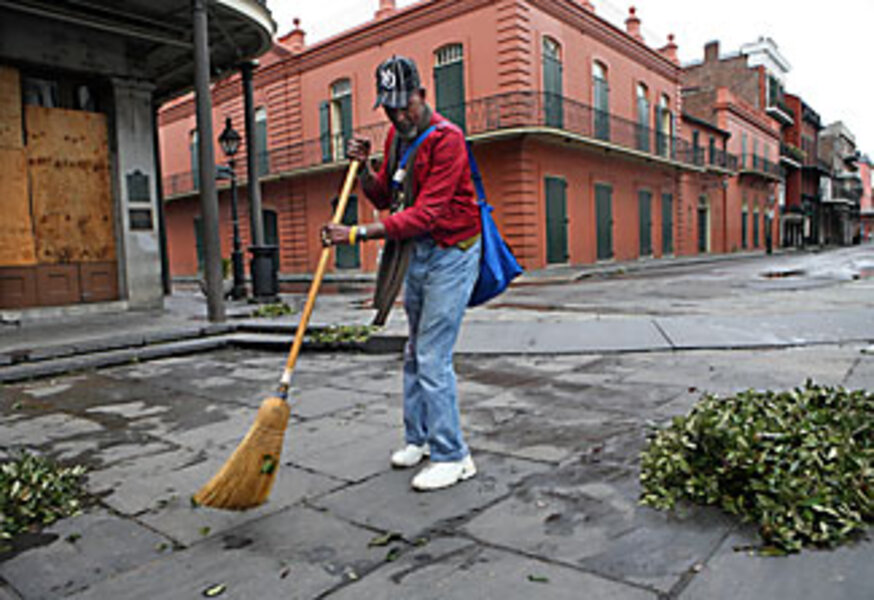How New Orleans weathered Gustav
Loading...
| New Orleans
New Orleanians and the world held their collective breath Monday as hurricane Gustav huffed and puffed but ultimately failed to blow this old port town down.
As a meteorological monster, hurricane Gustav was no hurricane Katrina, coming ashore as a Category 2 hurricane, compared with Katrina's Category 3 winds, and veering far enough west to do little but break tree limbs and fling a few truck-bed liners around New Orleans.
"The levees held, the levees held," New Orleans City Councilor Cynthia Willard-Lewis breathily reported. "Our spirit is unshaken."
Gustav's diminished strength and the much-ballyhooed improved cooperation among state, local, and federal officials certainly had a role in the city's survival. But the real keys were the up-armored levee system, a small task force of National Guard soldiers, heroic actions on storm-whipped levees, and, ultimately, a shift in Gulf Coast residents' view of their precarious perch on the Gulf.
"This was a good way for us to test ourselves a little bit," says healthcare worker Macon Moore, walking his dog, Rocky, in the mostly unscathed Garden District.
Even worries about Gulf oil rigs and refineries subsided, with the price of a barrel of sweet crude dropping $4 Monday. Although 1,836 people died as a result of Katrina, at time of writing seven were reported to have perished in Gustav, including a family of evacuees escaping to Atlanta.
Though it didn't turn out to the "mother of all storms" that Mayor Ray Nagin had predicted, Gustav still packed a wallop. Bayou communities on the west shore of Lake Pontchartrain were submerged nearly to rooftops, as the canal between Lake Pontchartrain and Lake Maurepas to the west spread into a vast expanse of angry and storm-chopped sea.
In the bayou burg of Morgan City, La., which took the brunt of Gustav's landfall, the Atchafalaya storm gates on Front Street creaked but held back the water. "Everyone's fine," reported dispatcher Allison Ganawey. "But it's been a little busy around here."
In Lafitte, La., Mayor Tim Kerner joined volunteer crews to lay water-filled rubber levees to hold back the waters. In Slidell, La., the Palm Lake neighborhood flooded under Gustav's five-foot storm surge, and some residents were evacuated by boat. Local authorities and volunteers worked throughout the night to shore up a levee near Belle Chasse, in St. Bernard Parish.
In New Orleans, tense moments gave way to relief, as storm waters that overtopped the Industrial Canal walls – which during Katrina had betrayed the Ninth Ward neighborhood – quickly subsided.
The city's salvation this time around lay ultimately with residents themselves, nearly 2 million of whom got out of Dodge in what's been called the largest evacuation in US history.
"They scared them real bad," says Glenn Davis, who weathered the storm in a rickety auto shop near the Marigny neighborhood. "The fact is people don't like being where they can't go anywhere." Mr. Davis was among the estimated 1,000 people who stayed in the city, not quite convinced that law enforcement officials could protect piles of tires stacked outside his shop.
Mr. Moore, the healthcare worker who also stayed through the storm, said his big concern as residents return to a city that will look just about the way they left it is that, next time, "they may grow complacent" when officials issue dire warnings. The stress of evacuation, too, he says, may make residents think twice about leaving the next time. "This is one of those times when you can't win for losing," he says.
Besides the orderly (though sometimes frustrating) evacuation, those who stayed here cited several reasons why New Orleans survived Gustav: Storm tracks predicted late last week held true, whereas Katrina made late-in-the-game jogs that bedeviled officials. Levees held back what officials called a "Level 3" event – a major test for the much-criticized federal levee-builders. With the streets empty, authorities could focus on trouble spots, such as sending manpower to shore up levees that protected refineries in Arabi, La. Moreover, built-in redundancies meant that mishaps that took weeks to fix after Katrina "now took two hours," says City Councilor Willard-Lewis.
But perhaps the most critical aspect to the city's successful rejoinder to Gustav could be found, in camouflage, at the downtown Holiday Inn.
Since Katrina, the Holiday Inn has been base camp to 350 Louisiana National Guard soldiers – Task Force Gator. Made up mostly of rural police officers here to shore up the undermanned New Orleans Police Department, Task Force Gator has served to relax tensions between the city's poor and the NOPD. Regular sightings of troops in desert-colored Humvees have irked some Crescent City residents who consider their presence to be military occupation. But to others they are a reassuring sight.
The National Guard troops "are more relaxed and they seem interested in getting to know people," says Denny Prieur, an auto mechanic who stayed for the storm.
In other words, residents say, Task Force Gator helped to ease the deep class divides that Katrina revealed and, in some cases, exacerbated – a major factor in convincing nearly a quarter-million New Orleanians that their homes, cars, boats, and furniture would be there when they returned to the city this time.
A looming question during post-storm assessments will certainly revolve around the role of the National Guard. For now, Task Force Gator is scheduled to be disbanded in January.





